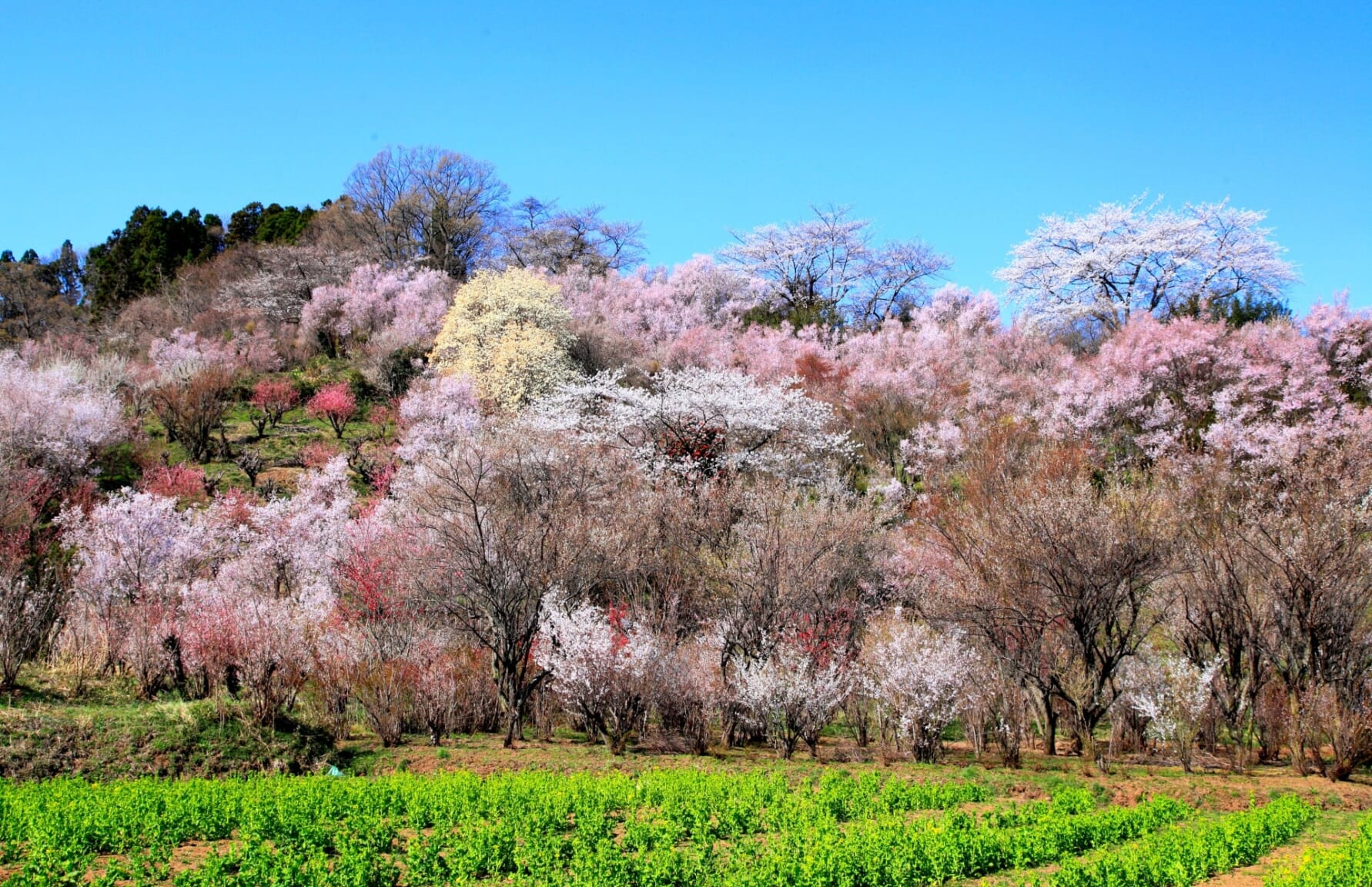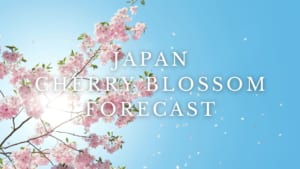10 Best Spots to View Cherry Blossoms in Fukushima
Fukushima Sakura Guide: Where to See Beautiful Cherry Blossoms in Fukushima

Fukushima Prefecture is a stunning destination any time of year, but during cherry blossom season, it comes alive with vibrant bursts of pink shades. Suppose you’re lucky enough to visit during this special time of year. In that case, you won’t want to miss the opportunity to witness the sakura spring magic, which also takes place slightly later than Tokyo because of the northern Tohoku climate.
There are so many great spots to choose from, from the ancient and awe-inspiring to the modern and scenic, so we’ve narrowed down the top ten cherry blossom spots that you should add to your Fukushima sakura bucket list!
1. Miharu Takizakura

This impressive tree was designated a national natural monument in 1922 and is one of the three most famous cherry trees in all of Japan. In addition, Miharu boasts 70 other shidarezakura trees that are over one hundred years old, so it’s worth it to explore the town after paying your respects to the venerable Takizakura.
 Access Access |
10-min drive from Miharu Station |
|---|---|
 Official Website Official Website |
https://fukushima.travel/destination/miharu-takizakura/7 |
2. Kasumigajo Park

Additionally, the park is famous for its fall chrysanthemum festival, which showcases beautifully displayed flowers and autumn colors. The park also pays homage to the Nihonmatsu Shōnentai, a group of teenage boys who died defending the castle during the Boshin War. Don’t miss the park’s stunning nighttime illumination from 18:00 to 22:00 during the festival.
 Access Access |
4-min drive from Nihonmatsu Park |
|---|---|
 Official Website Official Website |
https://www.city.nihonmatsu.lg.jp/travel_guide/tourist_attractions/page002702.html |
3. Tsurugajo Castle Park

Visitors can enjoy the blossoms up close, from viewing platforms atop the castle, or relax in a traditional Japanese tea house. Free English-guided tours are available by booking through the Aizu-Wakamatsu City International Association but they must be booked 2 weeks in advance. Designated a national historic site, the castle’s moats and earthworks have remained intact for over 400 years.
 Access Access |
10-min drive from Nanukamachi or Aizu-Wakamatsu Station |
|---|---|
 Official Website Official Website |
https://www.tsurugajo.com/language/eng/ |
4. Natsui Senbon Zakura

The view of the river as it winds its way through the cherry blossoms is calming and picturesque. You can take a leisurely stroll along the promenade to capture the sparkling river alongside the cherry blossoms. Don’t forget to look out for the daffodils that also bloom alongside the river in springtime.
 Access Access |
5-min walk from Natsui Station |
|---|---|
 Official Website Official Website |
https://onokankou.jimdofree.com/%E8%A6%B3%E5%85%89-%E8%87%AA%E7%84%B6/ |
5. Cherry Blossoms along Nicchu Line

The restoration of the train tracks now offers a unique walking experience in a path that transforms in a neverending cherry blossom tunnel during sakura seasons. There’s also the chance to see the antique steam train currently on display along the way, which used to run on the Nicchu Line.
For more information about Nicchu Line cherry blossoms, check the following article:
▶Nicchu Line Weeping Cherry Blossoms
 Access Access |
20-min walk from Kitakata Station |
|---|---|
 Official Website Official Website |
http://www.kitakata-kanko.jp/category/detail.php?id=104 |
6. Kannonji River

The river maintains its natural curves and bends, and the cherry trees rank as the 11th best place to see cherry blossoms in the entire Tohoku region. During cherry blossom season, street vendors provide tasty food, perfect for a riverside picnic. In the evening, the flowers are illuminated, creating an even more stunning display where the night river landscape transforms into a magical dreamscape.
 Access Access |
8-min walk from Kawageta Station |
|---|---|
 Official Website Official Website |
https://bandaisan.or.jp/ib/en/ |
7. Hanamiyama

Renowned photographer Shotaro Akiyama even called it a “peach garden”. The contrast between the colorful flowers and the snow-capped Azuma mountains is a sight to behold. There are guides are available to help you make the most of your visit, but finding a favorite spot to take in the scenery is always an option. With gorgeous scenery in every season, Hanamiyama Park should be at the top of your must-visit spots if you plan to visit Fukushima.
For more information about Hanamiyama Park, check the following article:
▶Hanamiyama Park: Flower-Filled Shangri-La in Fukushima
 Access Access |
12-min drive from Fukushima Station |
|---|---|
 Official Website Official Website |
https://www.hanamiyama.jp/en/ |
8. Toda River

The best time to catch the trees in full bloom is from mid to late April, and if you’re lucky, you may catch the sight of the cherry blossoms reflected on the surface of the river.
 Access Access |
15-min walk from Kikuta Station |
|---|---|
 Official Website Official Website |
https://www.kanko-koriyama.gr.jp/tourism/detail5-1-426.html |
9. Kaiseizan Park

During the cherry blossom festival in April, visitors can enjoy the sights both during the day and at night, with light displays and food stalls. The Kaiseizan Grand Shrine, which is situated nearby, is also a popular spot for cherry blossom viewing. Don’t miss the opportunity to experience this breathtaking sight.
 Access Access |
8-min drive from Koriyama Station |
|---|---|
 Official Website Official Website |
https://www.kanko-koriyama.gr.jp/tourism/detail2-1-349.html |
10. Sasahara River Senbonzakura

The trees were planted by locals along the repaired embankment after the river was reconstructed in the 1950s to prevent flood damage. The area’s outstanding beauty was recognized with the Cherry Blossom Merit Award from the Japan Cherry Blossom Society in 1996. During the Sasahara River “Thousand Cherry Trees Festival,” held when the cherry blossoms are in full bloom, the area is illuminated at night, making for a breathtaking view.
 Access Access |
18-min drive from Asakanagamori Station |
|---|---|
 Official Website Official Website |
https://www.kanko-koriyama.gr.jp/tourism/detail5-1-431.html |
▽Subscribe to our free news magazine!▽
If you ever wanted to explore around Fukushima Prefecture, now is the best time to plan for it!
For more information about spring in Japan, check out the following articles!
▽Related Articles▽
▼Editor’s Picks▼
Written by
Photographer, journalist, and avid urban cyclist, making sense of Japan since 2017. I was born in Caracas and lived for 14 years in Barcelona before moving to Tokyo. Currently working towards my goal of visiting every prefecture in Japan, I hope to share with readers the everlasting joy of discovery and the neverending urge to keep exploring.













